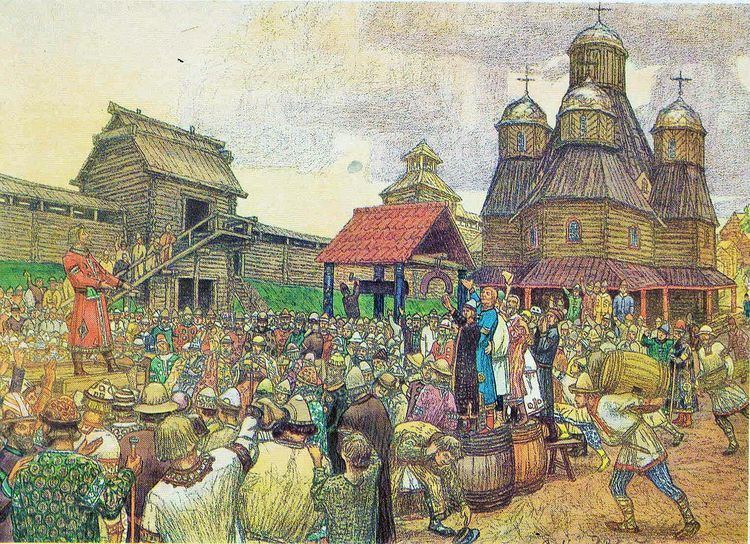 | ||
Veche (Russian: вече, Polish: wiec, Ukrainian: віче, Belarusian: веча, Old Church Slavonic: вѣштє) was a popular assembly in medieval Slavic countries.
Contents
In Novgorod, where the veche acquired the greatest prominence, the veche was broadly similar to the Norse thing or the Swiss Landsgemeinde.
Etymology
The word is inherited from Proto-Slavonic *větje , meaning 'council', 'counsel' or 'talk' (which is also represented in the word "soviet", both ultimately deriving from Proto-Slavic verbal stem of *větiti 'to talk, speak')[1] also related to "-vice" in "advice", and somewhat more distantly to Sanskrit "Veda", Germanic words like "wise" (English), "weten" (Dutch, "to know"), "witch" (Slavonic: věšt-ica) and many other.
The semantic derivation that yields the meaning of the word under consideration is parallel to that of congregation. The contemporary words svedeniya (Russian: сведения) and svidchennya (Ukrainian: свідчення) both meaning "information" are cognates of this word.
Rus
The East Slavic veche is thought to have originated in tribal assemblies of Eastern Europe, thus predating the Rus' state. The earliest mentions of veche in East European chronicles refer to examples in Belgorod Kievsky in 997, Novgorod the Great in 1016 and in Kiev in 1068. The assemblies discussed matters of war and peace, adopted laws, and called for and expelled rulers. In Kiev, the veche was summoned in front of the Cathedral of St Sophia.
In Ukraine, the town viche was simply a gathering of community members to inform everybody of important events (vich-na-vich - eye-to-eye) and come up with a collective planning for the near future.
Novgorod Republic
The veche was the highest legislature and judicial authority in the Republic of Novgorod until 1478, after the conquest of Novgorod by Grand Prince Ivan III.
The traditional scholarship goes on to argue that a series of reforms in 1410 transformed the veche into something similar to the public assembly of Venice; it became the Commons or lower chamber of the parliament. Аn upper Senate-like Council of Lords (sovet gospod) was also created, with title membership for all former city magistrates (posadniks and tysyatskys). Some sources indicate that veche membership may have become full-time, and parliament deputies were now called vechniks. Some of the more recent scholars call this interpretation into question.
The Novgorod assembly could be presumably summoned by anyone who rung the veche bell, although it is more likely that the common procedure was more complex. The whole population of the city - boyars, merchants, and common citizens - then gathered at Yaroslav's Court or in front of the Cathedral of Holy Wisdom (the latter called a Vladychnoe veche - "An Archbishop's Veche," since it was called in front of the cathedral). The veche bell was a symbol of republican sovereignty and independence and for this reason, Ivan III carted it off to Moscow when he took control of the city, to show that the old way of doing things was at an end.
Separate assemblies could be held in the boroughs or "Ends" of Novgorod.
Of all other towns of Novgorod Land, the chronicles only mention a veche in Torzhok, however possibly they existed in all other towns as well.
Pskov republic
In the Pskov Republic the veche continued until 1510, when that city was taken over by Grand Prince Vasilii III (1505–1533). In Pskov the veche assembled in the court of the Trinity cathedral.
Poland
Veches, known in Poland as wiece, were convened even before the beginning of the Polish statehood in the Kingdom of Poland. Issues were first debated by the elders and leaders, and later presented to all the free men for a wider discussion.
One of the major types of wiec was the one convened to choose a new ruler. There are legends of a 9th-century election of the legendary founder of the Piast dynasty, Piast the Wheelwright, and a similar election of his son, Siemowit (this would place a Polish ruler's election a century before an Icelandic one's by the Althing), but sources for that time come from the later centuries and their validity is disputed by scholars. The election privilege was usually limited to the elites, which in the later times took the form of the most powerful nobles (magnates, princes) or officials, and was heavily influenced by local traditions and strength of the ruler. By the 12th or 13th centuries, the wiec institution likewise limited its participation to high ranking nobles and officials. The nationwide gatherings of wiec officials in 1306 and 1310 can be seen as precursors of the Polish parliament (the general sejm).
